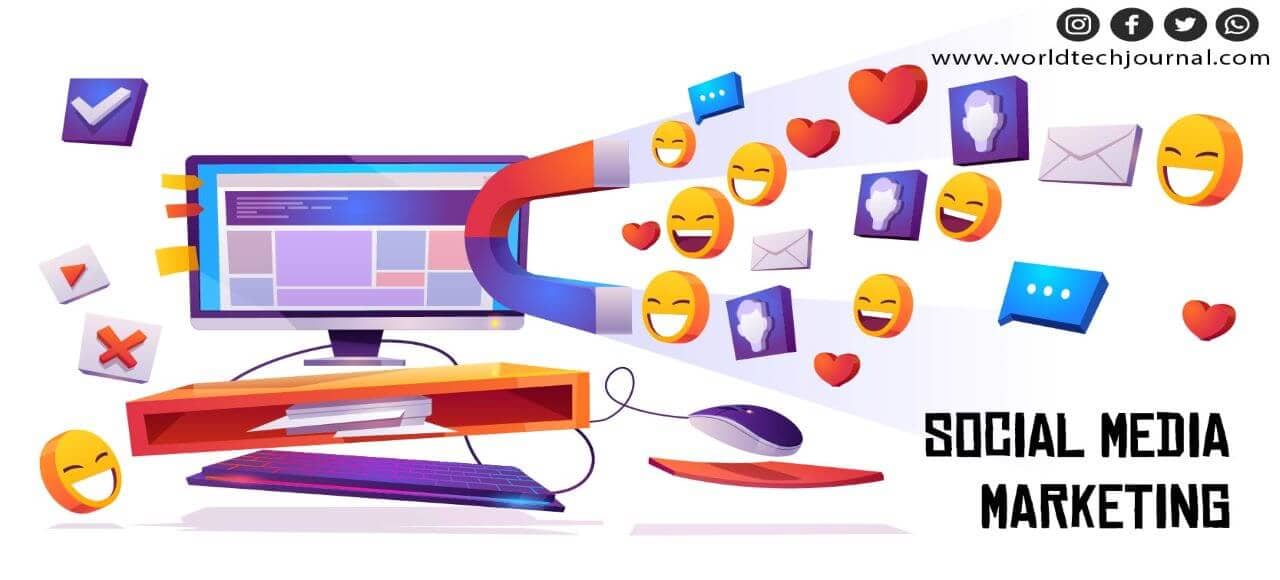Social media marketing which is a form of digital marketing is becoming popular rapidly. All the types of social media marketing can help you a lot to grow your business.
As different social media platforms are growing rapidly especially for young generations, so it a great way to grow your customers there.
In this guide I will discuss in details about different types of social media marketing with pros and cons.
Before going to the types of social media marketing, lets learn what is social media marketing first.
What is social media marketing?
Digital marketing includes social media marketing, which uses the social media network to attract consumers to the website.
Social networks and social media are used to promote a business’s line of goods and services.
In order to reach out to prospective consumers, social media marketing mostly focuses on improving user communication and brand awareness.
Popular websites provide services like Instagram followers, Facebook comments, and YouTube subscribers that may be purchased in addition to website traffic.
Social media marketing platforms will assist you in interacting with your clients, prospects, and leads.
Importance of social media marketing
Social media might provide your company greater awareness in developing your brand and growing your online presence beyond your website with the right content.
Social media also aids in bridging the gap between you and prospective clients.
Social media, on the other hand, enables companies to transform their clients into brand ambassadors and aids in raising brand recognition.
See also top 20 benefits of social media for business.
Now, lets see that how many popular types of social media marketing are there.
Types of social media marketing
Although there are several types of social media marketing today, here are the major types of social media marketing with details.

1. Content marketing
A strategic marketing tactic is content marketing. It involves creating and disseminating information in order to draw in and keep consumers.
Making and distributing any blog entries, videos, podcasts, emails, or infographics you choose. When it comes to content marketing, it’s not just about producing quality material.
The data need to be logically written and presented. understanding what your target audience wants.
And it’s even better when your content aids in your business’s accomplishment of its goals.
See also 5 stages to improve YouTube content strategy.
2. Advertising/ sponsorship
Advertising is a kind of non-personal, publicly funded audio and visual marketing communication that promotes or sells a product, service, or idea.
Advertising is often thought of as a paid message that you own.
Publications in magazines and newspapers, as well as advertisements on TV, radio, internet, and other social media platforms, are common techniques.
In contrast to public relations initiatives, you choose, produce, and deploy the precise message you want.
Creating your advertisements and putting them up on various social media sites are included in your advertising costs.
A sponsor is a person or group that pays for or helps to the expenses of putting on an athletic or artistic event in return for publicity.
A company would provide goods or cash to a user account in order to promote or sell something.
This sort of partnership is known as social media sponsorship.
The sponsor may be a person or business that contributes funds to another social media account in return for advantages.
3. Influencer marketing
One of the finest forms of social media marketing is influencer marketing. But what does “influencer” really mean?
A person who has developed a devoted following on social media is known as a social media influencer.
This influencer can be a YouTuber, a blogger, or a member of another group.
However, they may be able to persuade the audience to purchase the product via content development.
Therefore, influencer marketing is a sort of advertising in which a business collaborates with an influencer who advocates for or has a dedicated following for a certain product.
Influencers share their content with their audience as a consequence, increasing business exposure and contributing in the conversion of followers into customers.
Examples of influencer marketing include the following:
- Sharing a promo code so that the audience of the influencer may benefit.
- Product reviews on social media.
- New product releases and brand promotions are communicated.
- Jointly developing a product or marketing campaign with the influencer.
- Using influencers to produce content for your company, such as blogs, videos, and social media advertisements.
Managing social media in an organic way.
You must communicate with the users of your social media network. Therefore, if you continue to work at it and put up effort, you may attract more followers.
But it takes a long time for this to occur. Although there are significant benefits, this is a long-term approach.
4. Social media management
Therefore, when you first start managing your social media accounts, it may not result in more followers at first, but after a year or two, you could have a sizable following of devoted fans.
This has the potential to significantly increase your company’s revenue. Higher ROI is made possible with the use of social media marketing.
5. Paid media marketing
Inorganic marketing initiatives that are managed by a paid placement agency are referred to as paid media. This implies that you must pay for your advertising.
The use of paid media has grown in importance for internet enterprises. Therefore, it is vital to buy online ad space in order to market a product to a wider audience.
Paid media is a component of a brand’s entire marketing plan to enhance click-through rates, sales, and traffic.
Types of Paid Media
- Paid Social Media
- Ads on search engines
- Display ads
- Native Ads
Types of Paid Pricing Models
- Cost Per Click (CPC)
- Cost Per Thousand/Mille (CPM)
You may like detail guide to affiliate marketing with 150 plus affiliate programs.
Top 10 advantages of social media marketing
A staggering 83% of internet users and around 51% of the world’s population utilize social media.

There are several advantages to being on such a large platform, including:
1. Establish direct contact with your clients
You may interact with your consumers in an unmediated and direct way on social media. Any other method of doing this would be very tough.
Just consider how few individuals you can interact with face-to-face in a physical business.
You have very little influence over how they engage and where the discussion goes throughout that touch.
You have a lot more influence over the issue on social media. You also have considerably more of a scope.
Many consumers now take this level of availability for granted. Before deciding on a company or product, more than one-third of customers will search for a social media presence.
Additionally, 49% of individuals look at social media reviews before making a purchase.
There is potential for a wonderful bond. You must carefully consider how you want that link to appear if you want to do this correctly. You may simplify your message for your audience in this manner.
And this is really important: if your audience doesn’t connect with your message or if you don’t respond to their comments or queries right away, your online presence will quickly backfire.
2. Enhanced brand recognition
It all comes down to sheer volume. Once again, almost everyone in the globe uses social media.
Going on social media platforms is like utilizing the world’s greatest megaphone if you want to reach a wider audience.
But do you really need a megaphone for your company? Consider your product or service while deciding how to respond to this inquiry. Do you operate a small furniture shop?
If so, maybe you don’t require a great deal of more awareness. However, if you want to start taking online orders or providing a virtual service, it can be the perfect solution.
Making ensuring that your material is seen by the right people, at the right time, and in the right location requires that you genuinely understand your audience and target appropriately.
You may join groups or create advertising on Facebook that target users based on criteria like age, location, and search history.
For instance, if you provide expert hanging services, you may reach locals who have sought for paintings or frames. If you know exactly who your audience is, that’s quite fantastic.
3. Increased website traffic
The evidence is in the numbers: 75% of marketers and almost 90% of marketers claim that their social marketing activities have boosted traffic and visibility for their businesses.
Therefore, it’s a terrific place to start if you’re looking to spread the word and attract more visitors to your website.
This may be accomplished by simply posting often and being prompt in your responses to online interactions.
Having said that, you want quality traffic, not simply any traffic. These are the folks who really wish to collaborate with you or purchase your goods or services.
Understanding your clients can help you qualify your traffic and raise awareness of your brand since you will know who they are and how to contact them.
To put it another way, you must do research.
Your traffic will increase more rapidly and regularly if you can connect with your clients on a genuine level and “speak their language.”
See also 5 best tools to check any websites traffic.
4. Recognizing the viewpoints of your clients
Your consumers will be sure to let you know on social media whether they really like a certain product or if they were dissatisfied with the level of customer care.
Engaging with companies on social media and sharing loves, dislikes, and everything in between is very fine.
Because of this, social media will generate far more interaction for you than any other channel.
This may be a useful tool that enables you to quickly and effectively examine what’s working and pinpoint areas that need improvement.
How? Simply read the comments to learn what other people are saying. Do you get a lot of attention when you provide a certain service, such as skilled home remodeling assistance?
Do people say that a product doesn’t function when you write about it?
Pay close attention to what is being said.
By asking direct questions, you can steer the conversation and are guaranteed to get many more replies than you would from a conventional survey.
5. Higher conversion rates
There is more money when there are more competent workers. To be clear, this is not just about sheer volume.
It involves creating a clientele of clients that like your company and often make purchases from you.

You may keep developing connections with that audience by maintaining a consistent social media presence.
Customers who may otherwise completely forget about your product or service after their first purchase will benefit from your ability to stay in their minds.
This can be a game-changer: While gaining a new customer might cost up to five times as much as maintaining an existing one, 66% of repeat consumers spend more money on the businesses they love.
So maintaining your current contacts may result in higher conversion rates.
Again, however, you must consider if you can really maintain your social media presence in order for this to happen. Conversions must go up if you want to:
- Know what your consumers are interested in
- Regularly publish articles that address certain topics
- Quickly reply to comments and direct messages.
- Participate in the bigger industry.
- Adhere to standard practices, such as including a link in your Instagram profile or leveraging customer testimonials to boost purchases.
If you are unable to perform these things, your effort may not be worthwhile
6. Engaging the opposition
Your social media presence might help you stand out if a rival is closing the gap on you.
Say, for example, that a customer is debating where to go for dinner.
Online research reveals that one of the competitors has incredible social media images while the competing eatery has no online presence at all.
You may also like 10 tips to write engaging social media post.
It’s likely that they’ll choose the eatery with the photos. They are quickly sold since the cuisine seems to be delectable and the reviews are favorable.
Daily drama of this kind occurs. Social media may thus be a very powerful tool for tilting the odds in your favor.
This is particularly true if you wish to engage with your consumers by promoting a social cause or a brand personality.
7. Advertising initiatives with a high return on investment
With items like fliers, billboards, and magazine advertising, ad prices may spiral out of control, and it’s far more difficult to disperse cash or set budget limits.
On the other side, social media advertisements may be both cheaper and more successful.
And individuals really click: 92% of Instagram users claim to have followed a company, visited their website, or bought something after seeing it on the social media network.
Similar to this, during the last 30 days, the typical Facebook user globally clicked on 12 adverts.
In other words, consumers search and then click on adverts that catch their attention.
However, without the proper message and targeting, these expenses might soar, so you must focus on these elements to do this portion properly.
This relates to genuinely comprehending your audience and ensuring that you are producing the right material for them. Don’t simply assume; instead, do study.
8. Spend less overall
Social media moves quickly and is inexpensive. It often provides free passive advertising by by appearing on your audience’s newsfeed.
Utilizing the free interaction options that social media provides is the key here (rather than focusing on paid ads).
Though these platforms, it must be said, don’t provide a very high ROI, this might include things like hashtags and live stories.
Having said that, it may also be as simple as natural participation on social networking sites.
As the term suggests, organic interaction occurs when you are discovered by your audience.
That implies that you are not paying for their participation.
And it can truly work: 96% of B2B marketers successfully utilize LinkedIn to boost organic engagement.
If you deliver the appropriate message to the proper audience at a regular pace, you may find that they take longer to produce results but will ultimately save you a ton of money.
9. Develop a business culture
Social media is a terrific area to develop corporate culture and engagement if you’re trying to do so. And nowhere else is this feasible.
After all, just 4% of customers feel that advertising and marketers work with integrity, according to a report by the American Association of Advertising Agencies.
Meaning they don’t believe what “official” advertisements have to say Yikes.
You don’t face the same obstacle on social media. This implies that you may establish rapport with your audience and win their confidence by
- Allowing consumers to see “behind the scenes” of your business
- Displaying recommendations
- Giving individuals a chance to participate in your community.
10. Develop your group
Keep in mind that it’s not only about the customers that purchase from you. It also pertains to the individuals that make up your business and team.
Well, traditional advertising and job boards aren’t nearly as popular as they were ten years ago.
On social media, you can even be able to attract folks who aren’t actively hunting for work.
Additionally, you may learn more about them and determine whether or not they share the same values as your business.
Maintaining a consistent posting schedule while focusing on your brand message and individual voice helps accomplish this.
The folks that connect to that message will already be on your page when you do it.
Many of those folks could be looking for work, so it will be simple to post about your opportunities and strike up a dialogue.
Top 10 disadvantages of social media marketing
The bitter always follows the sweet, and everyone is aware that things may often go wrong on social networking sites.

Here are the major disadvantages of social media marketing.
1. You’ll get negative comments
Social media trolling is the most well-known aspect of social media.
Even if you have the greatest of intentions, your company will undoubtedly get unfavorable comments and criticism.
Before you make the social leap, consider how well your staff will be able to handle that criticism and remain above the fray.
What values would you uphold? Will you show trolls any respect? Humor?
When receiving unfavorable criticism, having a well-thought-out strategy may help you react promptly and successfully.
In order to do this, your plan may be to
- Killing them with compassion
- Use humor
- React with information
- Be distant, etc.
There are many possibilities, but you must have a plan.
2. There is a chance of humiliation
In a similar vein, you could lose control of the train, which is prone to running off the rails.
Additionally, having an uncontrolled social media presence might damage your brand’s reputation and your rapport with consumers.
Because of this, negotiating this environment needs skillful management and a grasp of your message.
Even comments and reactions to messages and concerns from customers might be considered to be examples of this.
Otherwise, a single unplanned incident might result in a huge windfall.
Create a strategy for how you will react, for instance, if someone says, “I despise this firm.”
You may say something sincere like, “We’re sorry to hear that! When we can improve, our customer care staff will DM you.
If you want to be hilarious, you may add something like, “We LOVE all of our customers and hope to see you soon.”
In any event, to stay in charge, choose your tone and stick with it.
3. Exorbitant advertising fees
Social media advertising expenditures may easily grow out of hand, especially if you don’t have a strong handle on your goals or your spending limit.
For instance, the average cost per click on Facebook is $5, while the daily cost of running a YouTube ad might be $10.
And with sponsored advertisements on websites like Instagram or Facebook, these figures rise even more.
This may not be the route for you if you own a small firm or have a limited marketing budget.
As an alternative, if you decide to continue through with any advertisements, be sure you have a professional working on it to keep the budget in check.
The ideal candidate can assist with planning and targeting so that unanticipated expenditures don’t get out of hand.
4. Investment returns that are modest
You are playing the long game while using social media. After all, developing an audience, perfecting your message, and boosting brand loyalty and engagement all take time.
Social media marketing is not the ideal option if you’re hoping for an immediate return on your investment.
However, if you’re playing the long game, it comes down to:
- Tracking the success of your campaign
- Examining your competitors’ websites
- Expanding on what is effective.
Have you ever run a campaign that had five times as much interaction as the others? Do it more often.
Do your rivals engage in any practices you’ve never considered? Integrate it into your plan to strengthen your long-term strategy.
5. Contact with rivals
You play with all the huge fish, little fish, and medium-sized fish on social media. After all, almost everyone uses the internet.
It might be challenging to generate interest and stand out from the throng in this situation.
This is especially valid if you:
- A smaller company
- Unfocused communication, or
- A recently created social media profile.
In such cases, it may not be worthwhile to put up the effort to compete with the “big boys.”
If so, you may want to reconsider your social media strategy and stick to using it as a way to keep in touch with your current clientele.
As an alternative, you may identify the unique differentiator that makes you stand out from the competition.
Do you provide a service that clients can’t get somewhere else? Do you support a cause that they are ignorant of?
Even if it’s modest, leave your imprint and engage with your community.
6. You must live up to high standards
The expectations of clients nowadays are greater than ever.
Consider this: consumers have access to everything they could possible need because to businesses like Amazon (sometimes before they even know they need it).
Simply mentioning an item might cause someone to start seeing advertisements for it even before they begin shopping.
When they actually go to make a purchase, they encounter a user interface that is easy to use, a ton of messaging that is highly tailored, and rapid answers to any queries they may have.
This is the pinnacle of personalization and forward-thinking targeting.
Customers now anticipate that degree of near-psychic ability and hyper-personalization from almost every business with which they deal.
If you use social media, you must be prepared to live up to these standards or risk losing followers. That implies you at the very least want prompt replies, tailored advertisements, and consistent contact.
7. Maintaining an active social media presence takes time
It takes a lot of work to meet very high client expectations and keep up your social media presence.
To stay in people’s minds, you should publish on social networking sites like LinkedIn at least once each day (and some platforms, like Twitter, call for even more frequent engagement).
Additionally, someone must be accessible to make comments and address clients. It takes a lot of time to do this.
Stay off the platforms if you don’t have the bandwidth, or spend money on a service or technology that can assist you in managing the process.
8. Social media a moving target
Social media best practices are always evolving.
With 2.8 billion users, Facebook continues to rule the social media world, but emerging platforms like TikTok, which has 680 million monthly users, are gaining popularity, especially among younger age groups.
There are often new features and functions that you need to keep in mind, even inside the platforms themselves. This includes newly added features like reels or Instagram Live.
You must create time for this since you must be willing to continuously learn and improve your tactics.
9. It’s challenging to stand out online
If you use social media, you are aware that 90% of the posts you see on the screen are easily scrolled over by users.
It takes something noteworthy to stand out in this flood of material, such as a fantastic product or something that evokes emotion (hello, puppy videos).
This is difficult to deliver consistently, and if you mess it, engagement will suffer.
Here, getting started is key to determining what will stay.
Try using photographs of social issues, humor, customer videos, or behind-the-scenes films. Take it from there after seeing how your audience reacts to it.
10. Highly qualified personnel are required
As you’ve undoubtedly already realized, highly skilled personnel who are really knowledgeable in social media are needed to execute it correctly.
Since this is a full-time job when done well, it may be a considerable investment. It may not be the greatest option for you if you lack the bandwidth.
To get the necessary credentials, you’ll have to identify the necessary personnel, locate an agency, or enroll in some courses on your own.
Last words
Social media marketing (SMM) is the practice of interacting with consumers using social media platforms in order to develop businesses, boost revenues, and improve website traffic.
As the use of social media develops throughout the globe, both on computers and mobile devices, the potential to generate revenue from specific user demographics is a booming industry with fierce competition for views and clicks.
However, I already have discussed very details about social media marketing. Now, let’s share your experience and opinion about social media marketing in the comment section bellow.
Recommended articles:
Types of digital marketing best tips and tricks for beginners
Tips to write engaging social media post
Best way of how to make money blogging
How to start a podcast and make money podcasting
How to increase organic social media reach?
5 main types of social media networks with benefits
Top 20 Benefits of Social Media for Business
Top 32 high paying freelance jobs in the world




